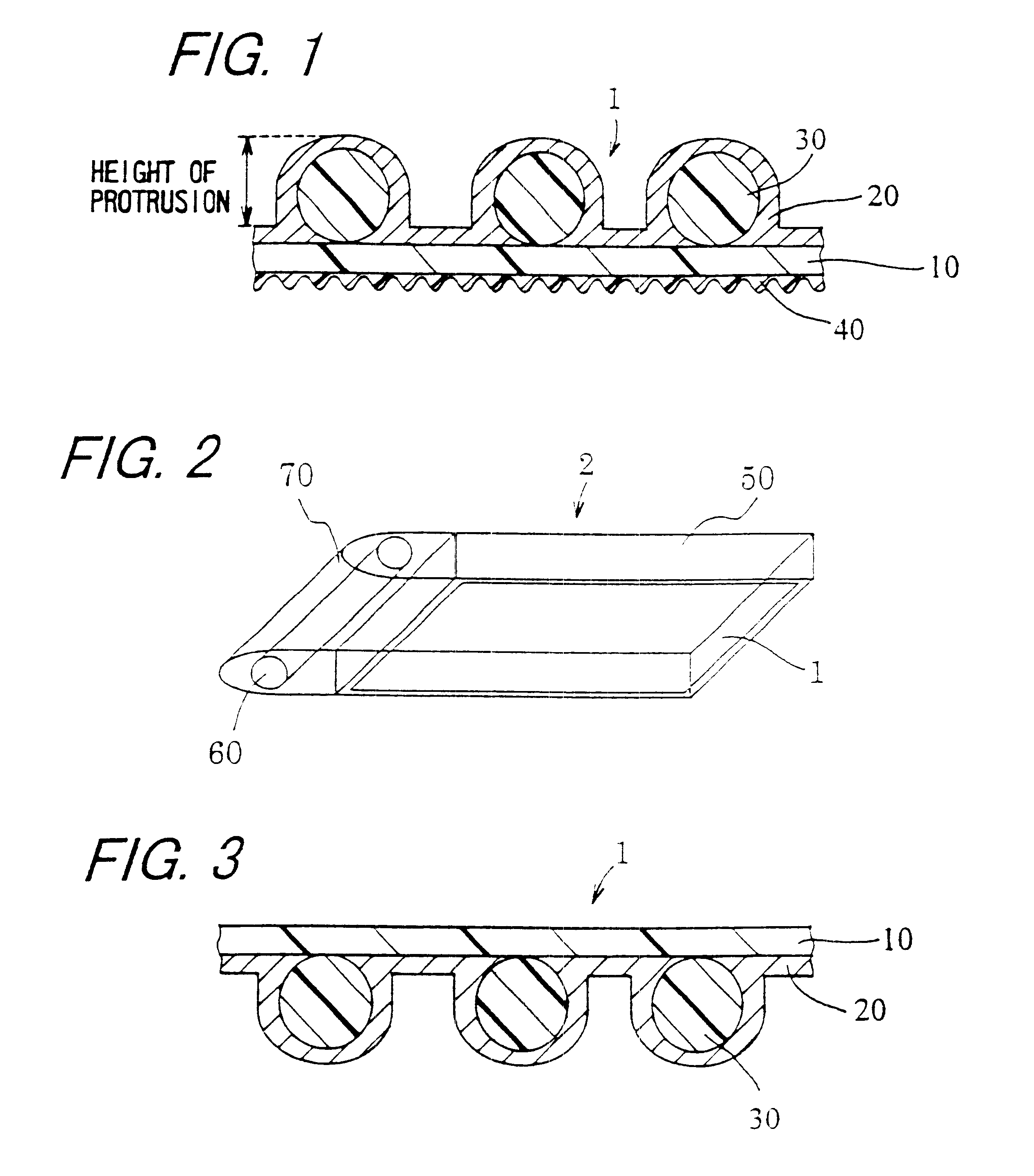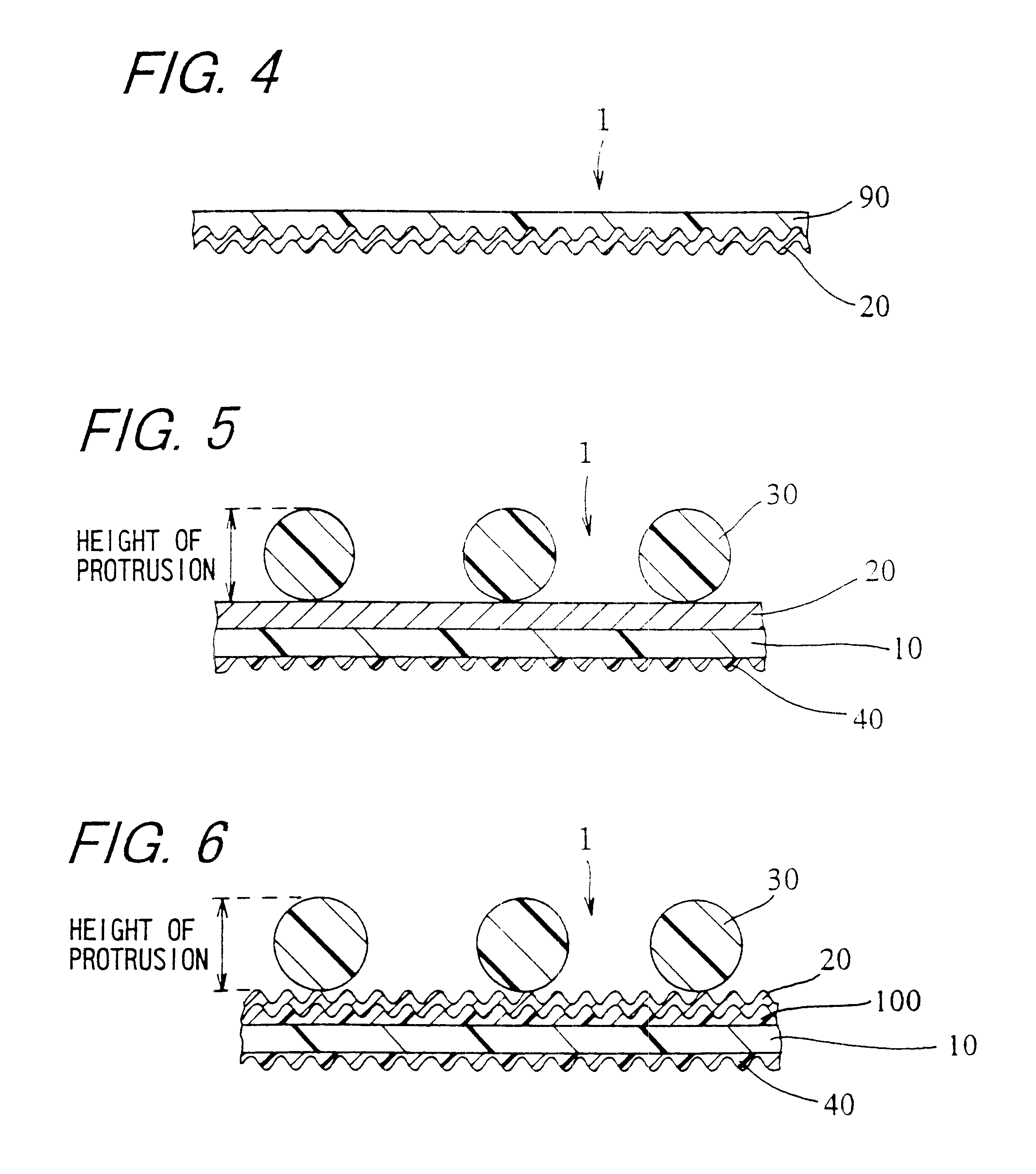Reflector, sidelight type backlighting apparatus and reflector substrate
a backlighting apparatus and reflector technology, applied in the direction of mirrors, mountings, instruments, etc., can solve the problems of irregular luminance, loss of diffuse reflection components, and insufficient illumination as a whole, and achieve the effect of improving brightness
- Summary
- Abstract
- Description
- Claims
- Application Information
AI Technical Summary
Benefits of technology
Problems solved by technology
Method used
Image
Examples
example 1
As the protrusions, acrylic particles 30 .mu.m in mean particle diameter were blended at an amount of 6.0 wt % in an acrylic resin binder, and a solution was prepared by adding a solvent comprising toluene and methyl ethyl ketone in such a manner that the solution may contain 24 wt % of solid matter. The resulting solution was applied to a 188-.mu.m thick PET film to obtain protrusions on the surface A. Then, acrylic particles 1.5 .mu.m in mean particle diameter were blended at an amount of 2.0 wt % in an acrylic resin binder, and a solution was prepared by adding a solvent comprising toluene and methyl ethyl ketone in such a manner that the solution may contain 15 wt % of solid matter. The resulting solution was applied to a PET film to obtain a smoothed surface on the surface B.
Subsequently, a zinc oxide layer was formed at a film thickness of 5 nm on the surface A side by means of DC magnetron sputtering using zinc oxide (purity: 99.9%) doped with 2% of Al.sub.2 O.sub.3 as the ta...
example 2
As the protrusions, acrylic particles 35 .mu.m in mean particle diameter were blended together with an acrylic resin binder at an amount of 5.5 wt % each, and a solution was prepared by adding a solvent comprising toluene and methyl ethyl ketone in such a manner that the solution may contain 24 wt % of solid matter. Then, a 188-.mu.m thick PET film one surface of which was subjected to sand blasting treatment was prepared, and the resulting solution was applied to the non-treated surface of the film to obtain protrusions on this non-treated surface (surface A). Then, a reflection layer 20 was formed in conformity with the condition of Example 1, whereby a reflector 1 was obtained. Subsequently, measurements were conducted in a manner similar to that described in Example 1 to obtain the following results: a total reflectance of 93.8%; a diffuse reflectance of 6.6%; a diffusivity of 7.0%; an average value for the height of the surface A side protrusions of 28.8 .mu.m; an average value...
example 3
As the protrusions, particles of acrylic resin (manufactured by Negami Kogyo Co., Ltd.) 5 .mu.m in mean particle diameter were blended together with an acrylic resin (manufactured by Mitsui Chemicals Inc., trademark Almatex) binder in a solvent comprising toluene and methyl ethyl ketone in such a manner that the resulting solution may contain 35 wt % of solid matter and that the particles may account for 10 wt % of the solid matter. Then, the resulting solution was applied to a 50-.mu.m thick PET film to obtain a protrusion layer. Subsequently, on the protrusion layer, a 5-nm thick layer of zinc oxide was formed as a light transmitting oxide film layer by means of DC magnetron sputtering using zinc oxide (99.9% purity) doped with 2% of Al.sub.2 O.sub.3 as the target and 99.5% pure argon as the sputtering gas. Then, without taking the film out from the sputtering apparatus, a 200-nm thick layer of silver was formed similarly as a silver layer by means of DC magnetron sputtering using...
PUM
 Login to View More
Login to View More Abstract
Description
Claims
Application Information
 Login to View More
Login to View More - R&D
- Intellectual Property
- Life Sciences
- Materials
- Tech Scout
- Unparalleled Data Quality
- Higher Quality Content
- 60% Fewer Hallucinations
Browse by: Latest US Patents, China's latest patents, Technical Efficacy Thesaurus, Application Domain, Technology Topic, Popular Technical Reports.
© 2025 PatSnap. All rights reserved.Legal|Privacy policy|Modern Slavery Act Transparency Statement|Sitemap|About US| Contact US: help@patsnap.com



